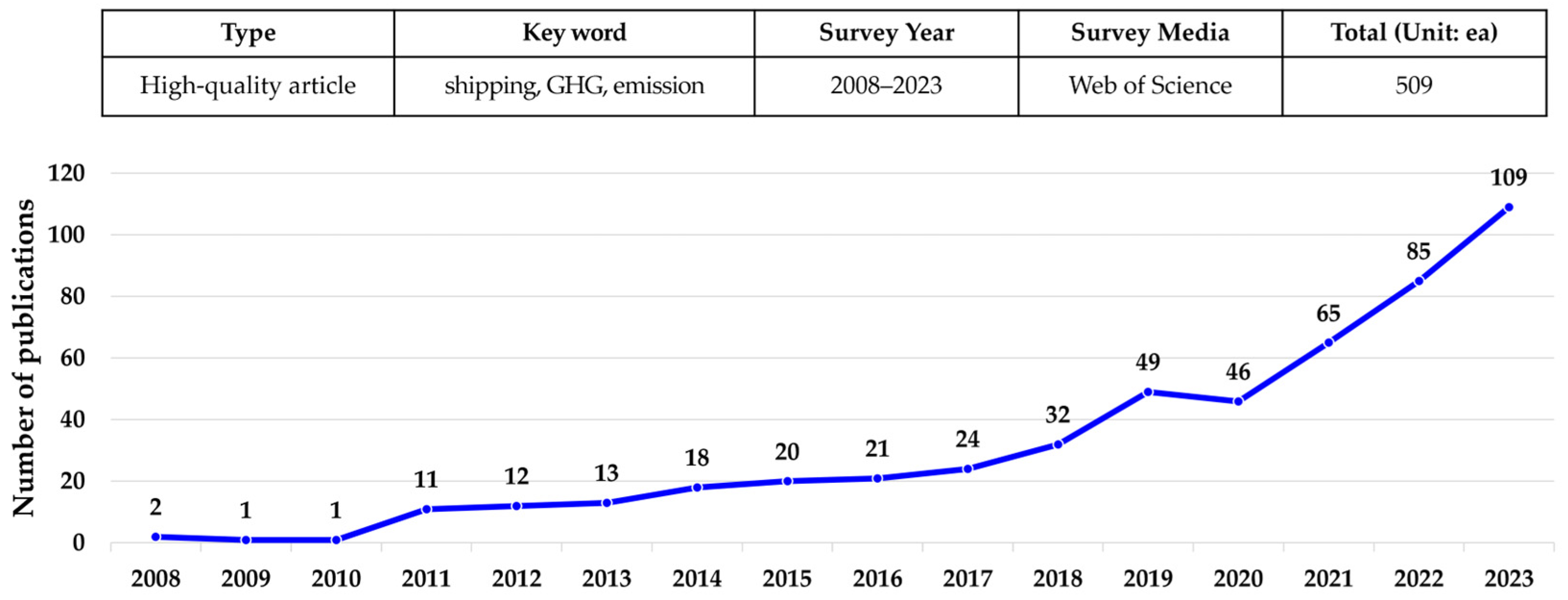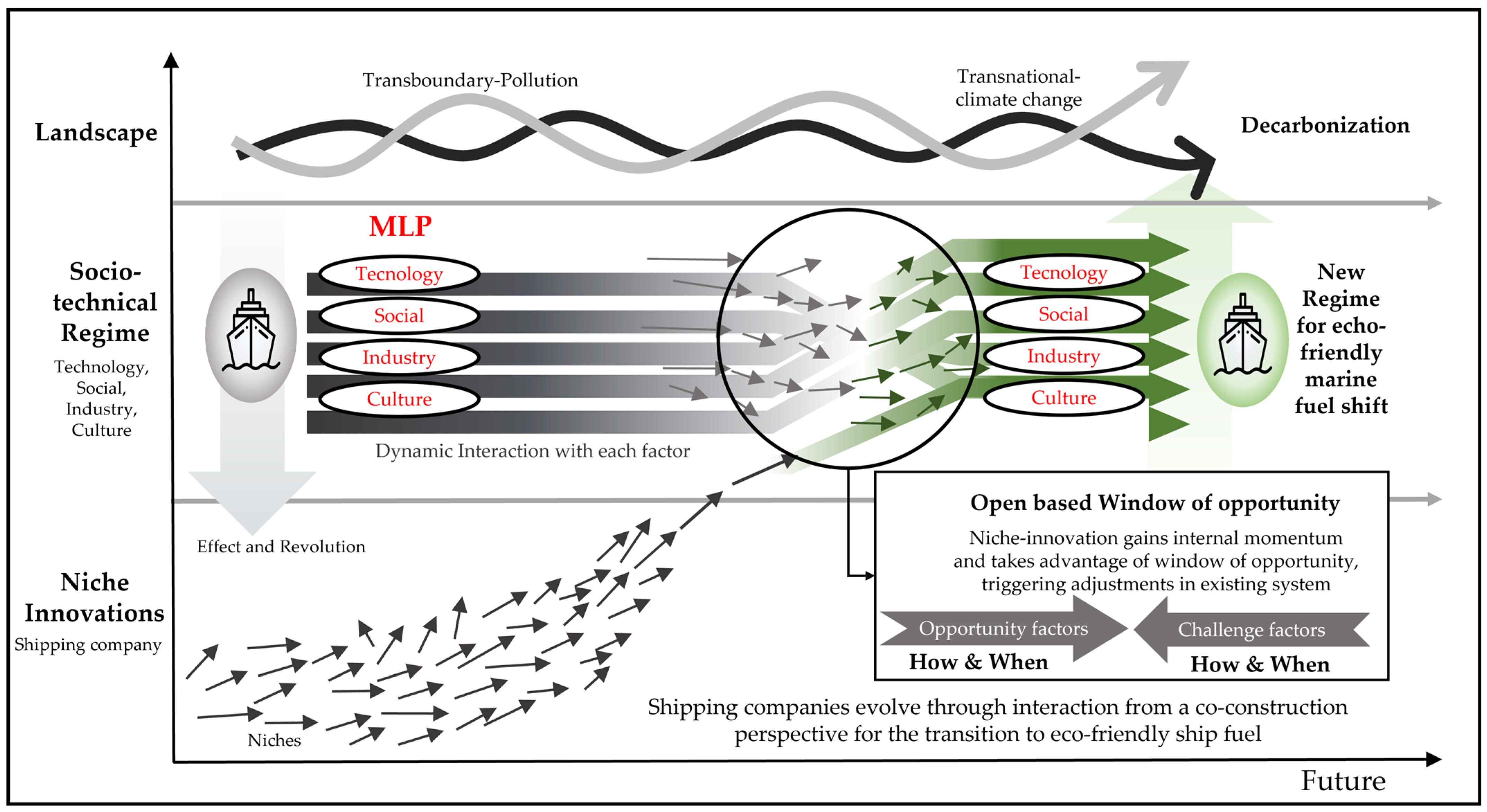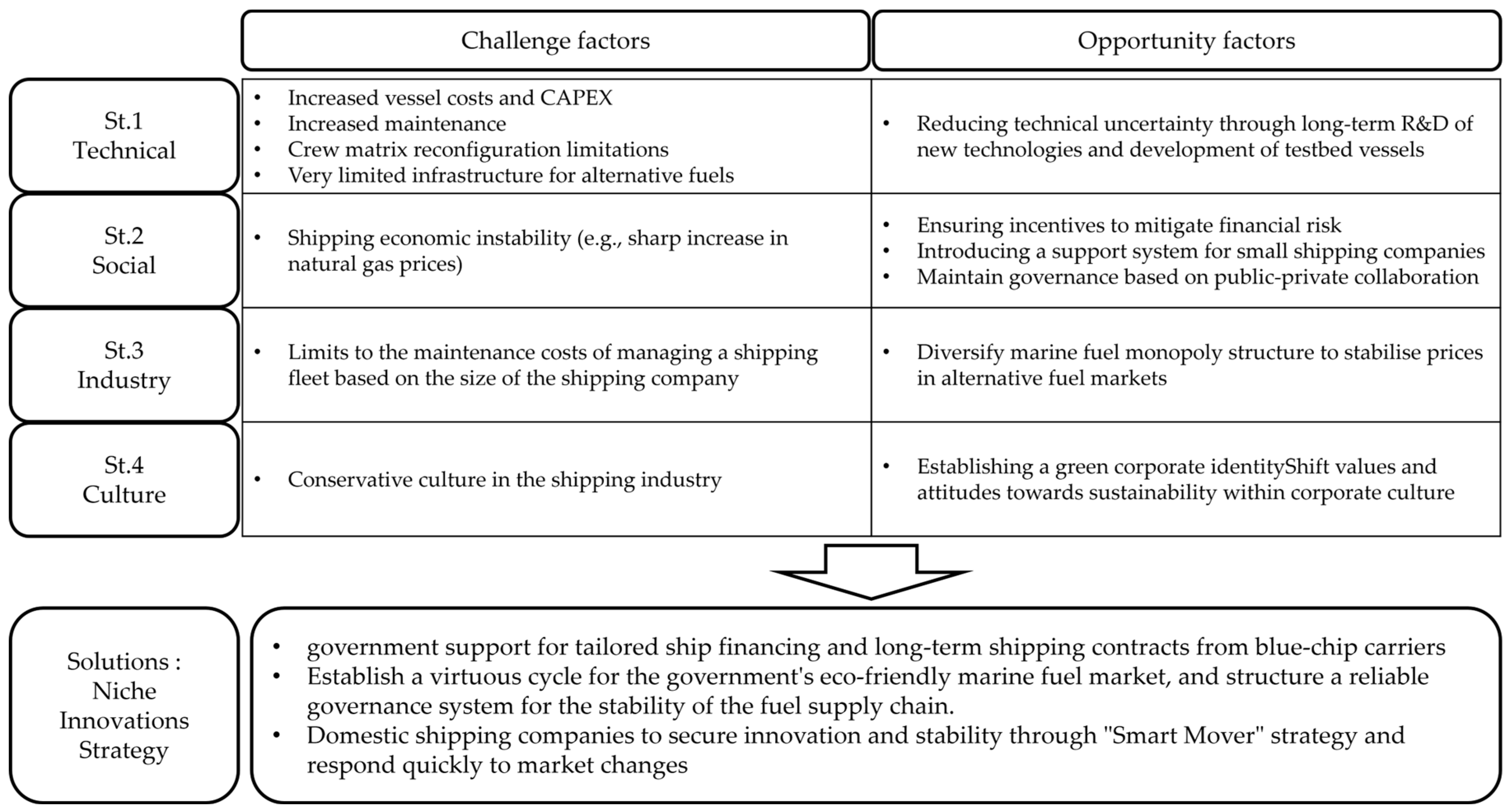Strategic Pathways to Alternative Marine Fuels: Empirical Evidence from Shipping Practices in South Korea
Abstract
1. Introduction
1.1. Background of Study
1.2. Literature Review
1.3. Research Approach Derived from Text Mining
1.3.1. Identifying Research Trends by Timing IMO Regulations through Text Mining
1.3.2. Research Question Derived from Text Mining
- What are the challenging factors in the shift to eco-friendly marine fuels?
- What are the opportunities for the shift to eco-friendly marine fuels?
- What is the Niche Innovations Strategy that integrates the opportunities and challenges of the shift to eco-friendly marine fuels?
2. Theory and Method
2.1. Theory
2.1.1. Theory for Environmental Justice and ESG
2.1.2. Theory of Air Pollution Regulation Based on Transnationality and Transboundary Principles
2.1.3. Sociotechnical Transition Theory of a Multilevel Perspective, including Window of Opportunity
2.2. Method for Analysis
3. Empirical Result
3.1. The Challenging Factors in the Shift to Eco-Friendly Marine Fuels
3.2. The Opportunities for the Shift to Eco-Friendly Marine Fuels
3.3. Innovative Strategy to Integrate the Opportunities and Challenges for Shifting to Eco-Friendly Marine Fuels
4. Discussion
5. Conclusions
Author Contributions
Funding
Institutional Review Board Statement
Informed Consent Statement
Data Availability Statement
Conflicts of Interest
References
- Serra, P.; Fancello, G. Towards the IMO’s GHG goals: A critical overview of the perspectives and challenges of the main options for decarbonizing international shipping. Sustainability 2020, 12, 3220. [Google Scholar] [CrossRef]
- McKinlay, C.J.; Turnock, S.R.; Hudson, D.A. Route to zero emission shipping: Hydrogen, ammonia or methanol? Int. J. Hydrogen Energy 2021, 46, 28282–28297. [Google Scholar] [CrossRef]
- Stark, C.; Xu, Y.; Zhang, M.; Yuan, Z.; Tao, L.; Shi, W. Study on applicability of energy-saving devices to hydrogen fuel cell-powered ships. J. Mar. Sci. Eng. 2022, 10, 388. [Google Scholar] [CrossRef]
- Elzen, B.; Geels, F.W.; Green, K. System Innovation and the Transition to Sustainability: Theory, Evidence and Policy; Edward Elgar Publishing: Cheltenham, UK, 2004. [Google Scholar]
- Verbong, G.P.; Geels, F.W. Exploring sustainability transitions in the electricity sector with socio-technical pathways. Technol. Forecast. Soc. Chang. 2010, 77, 1214–1221. [Google Scholar] [CrossRef]
- Geels, F.W. Regime resistance against low-carbon transitions: Introducing politics and power into the multi-level perspective. Theory Cult. Soc. 2014, 31, 21–40. [Google Scholar] [CrossRef]
- Geels, F.W. Technological transitions as evolutionary reconfiguration processes: A multi-level perspective and a case-study. Res. Policy 2002, 31, 1257–1274. [Google Scholar] [CrossRef]
- Rip, A.; Kemp, R. Technological change. Hum. Choice Clim. Chang. 1998, 2, 327–399. [Google Scholar]
- Markard, J.; Raven, R.; Truffer, B. Sustainability transitions: An emerging field of research and its prospects. Res. Policy 2012, 41, 955–967. [Google Scholar] [CrossRef]
- Stalmokaitė, I.; Yliskylä-Peuralahti, J. Sustainability transitions in Baltic Sea shipping: Exploring the responses of firms to regulatory changes. Sustainability 2019, 11, 1916. [Google Scholar] [CrossRef]
- International Maritime Organization (IMO). 2023 IMO STRATEGY on REDUCTION of GHG EMISSIONS from SHIPS; Resolution Mepc.377(80); International Maritime Organization (IMO): London, UK, 2023. [Google Scholar]
- Bach, H.; Hansen, T. IMO off course for decarbonisation of shipping? Three challenges for stricter policy. Mar. Policy 2023, 147, 105379. [Google Scholar] [CrossRef]
- Liu, J.; Liao, R.; Dong, F.; Huang, C.; Li, H.; Liu, J.; Zhao, T. Low-carbon technology selection and carbon reduction potential assessment in the shipbuilding industry with dynamically changing grid emission factors. J. Clean. Prod. 2024, 441, 140707. [Google Scholar] [CrossRef]
- Bilgili, L. A systematic review on the acceptance of alternative marine fuels. Renew. Sustain. Energy Rev. 2023, 182, 113367. [Google Scholar] [CrossRef]
- Xing, H.; Stuart, C.; Spence, S.; Chen, H. Alternative fuel options for low carbon maritime transportation: Pathways to 2050. J. Clean. Prod. 2021, 297, 126651. [Google Scholar] [CrossRef]
- Bilgili, L. Comparative assessment of alternative marine fuels in life cycle perspective. Renew. Sustain. Energy Rev. 2021, 144, 110985. [Google Scholar] [CrossRef]
- Hansson, J.; Månsson, S.; Brynolf, S.; Grahn, M. Alternative marine fuels: Prospects based on multi-criteria decision analysis involving Swedish stakeholders. Biomass Bioenergy 2019, 126, 159–173. [Google Scholar] [CrossRef]
- Deniz, C.; Zincir, B. Environmental and economical assessment of alternative marine fuels. J. Clean. Prod. 2016, 113, 438–449. [Google Scholar] [CrossRef]
- Chiong, M.-C.; Kang, H.-S.; Shaharuddin, N.M.R.; Mat, S.; Quen, L.K.; Ten, K.-H.; Ong, M.C. Challenges and opportunities of marine propulsion with alternative fuels. Renew. Sustain. Energy Rev. 2021, 149, 111397. [Google Scholar] [CrossRef]
- Elgohary, M.M.; Seddiek, I.S.; Salem, A.M. Overview of alternative fuels with emphasis on the potential of liquefied natural gas as future marine fuel. Proc. Inst. Mech. Eng. Part M J. Eng. Marit. Environ. 2015, 229, 365–375. [Google Scholar] [CrossRef]
- Hellström, M.; Rabetino, R.; Schwartz, H.; Tsvetkova, A.; Haq, S.H.U. GHG emission reduction measures and alternative fuels in different shipping segments and time horizons–A Delphi study. Mar. Policy 2024, 160, 105997. [Google Scholar] [CrossRef]
- Xiao, G.; Chen, L.; Chen, X.; Jiang, C.; Ni, A.; Zhang, C.; Zong, F. A hybrid visualization model for knowledge mapping: Scientometrics, SAOM, and SAO. IEEE Trans. Intell. Transp. Syst. 2023, 1–14. [Google Scholar] [CrossRef]
- Cyram Inc. NetMiner, Version 4.5.0. 2022. Available online: https://www.netminer.com/kr/ (accessed on 15 December 2023).
- Lee, J.; Lee, J.; Lee, C.; Kim, Y. Identifying ESG Trends of International Container Shipping Companies Using Semantic Network Analysis and Multiple Case Theory. Sustainability 2023, 15, 9441. [Google Scholar] [CrossRef]
- Lin, A.J.; Chang, H.-Y.; Hung, B. Identifying key financial, environmental, social, governance (ESG), bond, and COVID-19 factors affecting global shipping companies—A hybrid multiple-criteria decision-making method. Sustainability 2022, 14, 5148. [Google Scholar] [CrossRef]
- Zhou, Y.; Li, X.; Yuen, K.F. Sustainable shipping: A critical review for a unified framework and future research agenda. Mar. Policy 2023, 148, 105478. [Google Scholar] [CrossRef]
- Power, A.L.; Tennant, R.K.; Stewart, A.G.; Gosden, C.; Worsley, A.T.; Jones, R.; Love, J. The evolution of atmospheric particulate matter in an urban landscape since the Industrial Revolution. Sci. Rep. 2023, 13, 8964. [Google Scholar] [CrossRef] [PubMed]
- Moon, J.-Y.; Kim, E.; Choi, E.H. International Responses to Transboundary Air Pollution and their Implications. KIEP Res. Paper. Policy Ref. 2017, 11, 1–129. [Google Scholar] [CrossRef]
- Barreiro, J.; Zaragoza, S.; Diaz-Casas, V. Review of ship energy efficiency. Ocean Eng. 2022, 257, 111594. [Google Scholar] [CrossRef]
- Van den Bergh, J.C.; Bruinsma, F.R. Managing the Transition to Renewable Energy: Theory and Practice from Local, Regional and Macro Perspectives; Edward Elgar Publishing: Cheltenham, UK, 2008. [Google Scholar]
- Geels, F.W. The multi-level perspective on sustainability transitions: Responses to seven criticisms. Environ. Innov. Soc. Transit. 2011, 1, 24–40. [Google Scholar] [CrossRef]
- Geels, F.W. From sectoral systems of innovation to socio-technical systems: Insights about dynamics and change from sociology and institutional theory. Res. Policy 2004, 33, 897–920. [Google Scholar] [CrossRef]
- Dingil, A.E.; Rupi, F.; Esztergár-Kiss, D. An integrative review of socio-technical factors influencing travel decision-making and urban transport performance. Sustainability 2021, 13, 10158. [Google Scholar] [CrossRef]
- Geels, F.W.; Schot, J. Typology of sociotechnical transition pathways. Res. Policy 2007, 36, 399–417. [Google Scholar] [CrossRef]
- Pakizer, K.; Lieberherr, E.; Farrelly, M.; Bach, P.M.; Saurí, D.; March, H.; Hacker, M.; Binz, C. Policy sequencing for early-stage transition dynamics–A process model and comparative case study in the water sector. Environ. Innov. Soc. Transit. 2023, 48, 100730. [Google Scholar] [CrossRef]
- Aarhaug, J.; Tveit, A.K. How ‘within-regime’tensions can create windows of opportunity for new mobility services. Environ. Innov. Soc. Transit. 2023, 49, 100784. [Google Scholar] [CrossRef]
- Geels, F.W.; Schwanen, T.; Sorrell, S.; Jenkins, K.; Sovacool, B.K. Reducing energy demand through low carbon innovation: A sociotechnical transitions perspective and thirteen research debates. Energy Res. Soc. Sci. 2018, 40, 23–35. [Google Scholar] [CrossRef]
- Kleinhaus, K.; Voolstra, C.R.; Meibom, A.; Amitai, Y.; Gildor, H.; Fine, M. A closing window of opportunity to save a unique marine ecosystem. Front. Mar. Sci. 2020, 7, 1117. [Google Scholar] [CrossRef]
- Tarkkala, H.; Snell, K. ‘The window of opportunity is closing’—Advocating urgency and unity. Humanit. Soc. Sci. Commun. 2022, 9, 324. [Google Scholar] [CrossRef]
- Psaraftis, H.N.; Kontovas, C.A. Decarbonization of maritime transport: Is there light at the end of the tunnel? Sustainability 2020, 13, 237. [Google Scholar] [CrossRef]
- Moritz, J.; McPartlin, M.; Tuomisto, H.L.; Ryynänen, T. A multi-level perspective of potential transition pathways towards cultured meat: Finnish and German political stakeholder perceptions. Res. Policy 2023, 52, 104866. [Google Scholar] [CrossRef]
- Comtet, H.E.; Johannessen, K.-A. A socio-analytical approach to the integration of drones into health care systems. Information 2022, 13, 62. [Google Scholar] [CrossRef]
- Jang, H.; Mujeeb-Ahmed, M.; Wang, H.; Park, C.; Hwang, I.; Jeong, B.; Zhou, P.; Mickeviciene, R. Regulatory gap analysis for risk assessment of ammonia-fueled ships. Ocean Eng. 2023, 287, 115751. [Google Scholar] [CrossRef]
- Algayyim, S.J.M.; Saleh, K.; Wandel, A.P.; Fattah, I.M.R.; Yusaf, T.; Alrazen, H.A. Influence of natural gas and hydrogen properties on internal combustion engine performance, combustion, and emissions: A review. Fuel 2024, 362, 130844. [Google Scholar] [CrossRef]
- Al-Enazi, A.; Okonkwo, E.C.; Bicer, Y.; Al-Ansari, T. A review of cleaner alternative fuels for maritime transportation. Energy Rep. 2021, 7, 1962–1985. [Google Scholar] [CrossRef]
- Yong Ung, Y.; Sung Ho, P.; Dong Ho, J.; Chang Hee, L. Improving liquefied natural gas bunkering in Korea through the Chinese and Japanese experiences. Sustainability 2020, 12, 9585. [Google Scholar] [CrossRef]
- Liang, L.H. HMM Opts for Scrubbers on Its Twelve 23,000 Teu Giant Boxships. Available online: https://www.seatrade-maritime.com/asia/hmm-opts-scrubbers-its-twelve-23000-teu-giant-boxships (accessed on 26 January 2024).
- Rahman, R. HMM Orders Methanol-Fuelled 9000 TEU Vessels. Available online: https://www.porttechnology.org/news/hmm-orders-methanol-fuelled-9000-teu-vessels/ (accessed on 26 January 2024).
- Basdekis, C.; Christopoulos, A.; Katsampoxakis, I.; Nastas, V. The impact of the Ukrainian war on stock and energy markets: A wavelet coherence analysis. Energies 2022, 15, 8174. [Google Scholar] [CrossRef]
- Shi, J.; Zhu, Y.; Feng, Y.; Yang, J.; Xia, C. A prompt decarbonization pathway for shipping: Green hydrogen, ammonia, and methanol production and utilization in marine engines. Atmosphere 2023, 14, 584. [Google Scholar] [CrossRef]
- Korea Ocean Business Corporation. Ship S&LB(BBCHP) Program. Available online: https://www.kobc.or.kr/ebz/eng/contents.do?mId=0302010000 (accessed on 26 January 2024).
- Poulsen, R.T.; Viktorelius, M.; Varvne, H.; Rasmussen, H.B.; von Knorring, H. Energy efficiency in ship operations-Exploring voyage decisions and decision-makers. Transp. Res. Part D Transp. Environ. 2022, 102, 103120. [Google Scholar] [CrossRef]
- Schwartz, H.; Solakivi, T.; Gustafsson, M. Is There Business Potential for Sustainable Shipping? Price Premiums Needed to Cover Decarbonized Transportation. Sustainability 2022, 14, 5888. [Google Scholar] [CrossRef]
- Rožić, T.; Naletina, D.; Zając, M. Volatile freight rates in maritime container industry in times of crises. Appl. Sci. 2022, 12, 8452. [Google Scholar] [CrossRef]
- Singh, S.; Dwivedi, A.; Pratap, S. Sustainable Maritime Freight Transportation: Current Status and Future Directions. Sustainability 2023, 15, 6996. [Google Scholar] [CrossRef]
- Moshiul, A.M.; Mohammad, R.; Hira, F.A. Alternative fuel selection framework toward decarbonizing maritime deep-sea shipping. Sustainability 2023, 15, 5571. [Google Scholar] [CrossRef]
- Maersk. Maersk Signs Landmark Green Methanol Offtake Agreement, Significantly De-Risking Its Low-Emission Operations in This Decade. Available online: https://www.maersk.com/news/articles/2023/11/22/maersk-signs-landmark-green-methanol-offtake-agreement (accessed on 26 January 2024).
- Jongseo, Y. How to Secure Eco-Friendly Competitiveness in the Domestic Shipping Industry; Korea Eximbank Overseas Economic Research Institute: Seoul, Republic of Korea, 2022. [Google Scholar]
- Sheikh, W.; Alom, K. Corporate governance, board practices and performance of shipping firms in Bangladesh. Asian J. Shipp. Logist. 2021, 37, 259–267. [Google Scholar] [CrossRef]
- Söderholm, P. The green economy transition: The challenges of technological change for sustainability. Sustain. Earth 2020, 3, 6. [Google Scholar] [CrossRef]
- Lee, J.-H.; Woo, J. Green New Deal policy of South Korea: Policy innovation for a sustainability transition. Sustainability 2020, 12, 10191. [Google Scholar] [CrossRef]
- Bunkering, K.L. TTS (Truck To Ship) Method. Available online: http://www.kolb.co.kr/en/contents/02_business/sub01.html (accessed on 26 January 2024).
- Beullens, P.; Ge, F.; Hudson, D. The economic ship speed under time charter contract—A cash flow approach. Transp. Res. Part E Logist. Transp. Rev. 2023, 170, 102996. [Google Scholar] [CrossRef]
- Liu, H.; Mao, Z.; Li, X. Analysis of international shipping emissions reduction policy and China’s participation. Front. Mar. Sci. 2023, 10, 1093533. [Google Scholar] [CrossRef]
- Lai, K.-H.; Lun, V.Y.; Wong, C.W.; Cheng, T.C.E. Green shipping practices in the shipping industry: Conceptualization, adoption, and implications. Resour. Conserv. Recycl. 2011, 55, 631–638. [Google Scholar] [CrossRef]







Disclaimer/Publisher’s Note: The statements, opinions and data contained in all publications are solely those of the individual author(s) and contributor(s) and not of MDPI and/or the editor(s). MDPI and/or the editor(s) disclaim responsibility for any injury to people or property resulting from any ideas, methods, instructions or products referred to in the content. |
© 2024 by the authors. Licensee MDPI, Basel, Switzerland. This article is an open access article distributed under the terms and conditions of the Creative Commons Attribution (CC BY) license (https://creativecommons.org/licenses/by/4.0/).
Share and Cite
Lee, J.; Sim, M.; Kim, Y.; Lee, C. Strategic Pathways to Alternative Marine Fuels: Empirical Evidence from Shipping Practices in South Korea. Sustainability 2024, 16, 2412. https://doi.org/10.3390/su16062412
Lee J, Sim M, Kim Y, Lee C. Strategic Pathways to Alternative Marine Fuels: Empirical Evidence from Shipping Practices in South Korea. Sustainability. 2024; 16(6):2412. https://doi.org/10.3390/su16062412
Chicago/Turabian StyleLee, Jeongmin, Minseop Sim, Yulseong Kim, and Changhee Lee. 2024. "Strategic Pathways to Alternative Marine Fuels: Empirical Evidence from Shipping Practices in South Korea" Sustainability 16, no. 6: 2412. https://doi.org/10.3390/su16062412
APA StyleLee, J., Sim, M., Kim, Y., & Lee, C. (2024). Strategic Pathways to Alternative Marine Fuels: Empirical Evidence from Shipping Practices in South Korea. Sustainability, 16(6), 2412. https://doi.org/10.3390/su16062412








